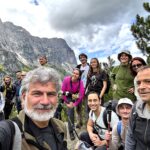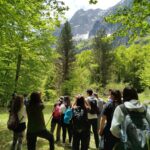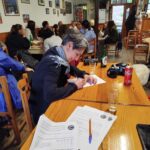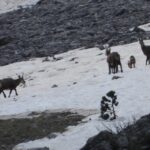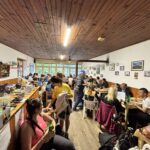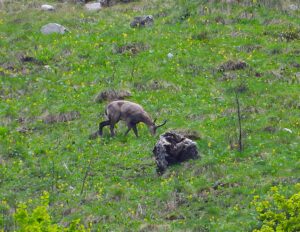
Author: Maria Petridou, 01/09/2025
Introduction
On May 11th, 2025, an educational excursion was organized on Mount Tymfi, in the wider area of Vrysochori, with the aim of introducing participants to the ecology and conservation of the Balkan chamois (Rupicapra rupicapra balcanica). The event attracted great interest, with more than 350 applications, out of which 47 individuals participated. The group consisted of 40 students and staff members from the University of Ioannina, alongside seven citizens, including professional mountain guides and members of the Mountaineering Club of Ioannina.
During the excursion, participants hiked through beech forests and alpine meadows, experiencing the rich biodiversity and scenic landscapes of Tymfi. Wildlife observations included groups of chamois with their young and a female bear with her cubs, offering a unique and powerful encounter with large mammals in their natural environment. Along the route, participants were also introduced to ecological concepts related to the chamois, its habitat requirements, and the importance of habitat connectivity for the long-term survival of the species.
The excursion received public visibility, as a reporter from the local television channel EpirusTV1 joined the event, capturing footage and conducting interviews. A short feature about the activity was subsequently broadcast, further highlighting the importance of the initiative and the high level of local interest (EpirusTV1, 2025; available at: https://www.youtube.com/watch?v=L1ElIdrY5hE)
To assess the educational impact and the experiential dimension of the activity, an anonymous structured questionnaire was distributed to all participants at the end of the excursion. In total, 45 out of 47 participants completed the questionnaire (response rate 96%). The questionnaire included both closed-ended and open-ended questions designed to capture (i) participants’ overall evaluation of the excursion, (ii) knowledge gained regarding the chamois and its habitat, (iii) perceptions of the importance of ecological connectivity, (iv) their direct experience of observing the species, and (v) their engagement and willingness to use the citizen-science mobile application “Agriogido.” Finally, an open-ended question invited participants to reflect on the most important experience they gained from the excursion, providing qualitative insights into the educational and social dimensions of the event.
Results
Q1. Overall evaluation of the excursion
Participants evaluated the excursion very positively. On a 0–10 scale, the mean score was 9.2 (±0.9). Scores ranged from 7 to 10, with the majority assigning the highest ratings (20 respondents gave a score of 10, 16 gave a score of 9, Fig. 1). Only three participants rated the excursion with 7, and six with 8.
These results indicate a consistently high level of satisfaction with the organization and content of the educational activity.

Figure 1. Overall evaluation of the chamois excursion by participants, assessed on a scale from 0 (poor) to 10 (excellent).
Q2. Knowledge gained
Question asked: “How much new knowledge did you gain on the following topics as a result of this experience?”
- The ecology of the chamois
- The habitat requirements of the chamois
- The threats faced by the chamois
- The importance of habitat connectivity for the survival of the chamois
Responses were given on a Likert scale from 1 = not at all, 2 = a little, 3 = medium, 4 = much, 5 = very much.
The educational excursion substantially enhanced participants’ knowledge of the chamois. Reported learning was consistently high across all four items, with mean values ranging from 4.33 to 4.64 on the 1–5 Likert scale. Most responses were concentrated in the upper scale categories, with 89–98% of participants selecting “much” or “very much” across the four topics (Fig. 2). Only a small minority of participants selected medium or lower categories.
These results indicate that the educational activity was effective in transmitting both ecological knowledge and conservation concepts to the participants.
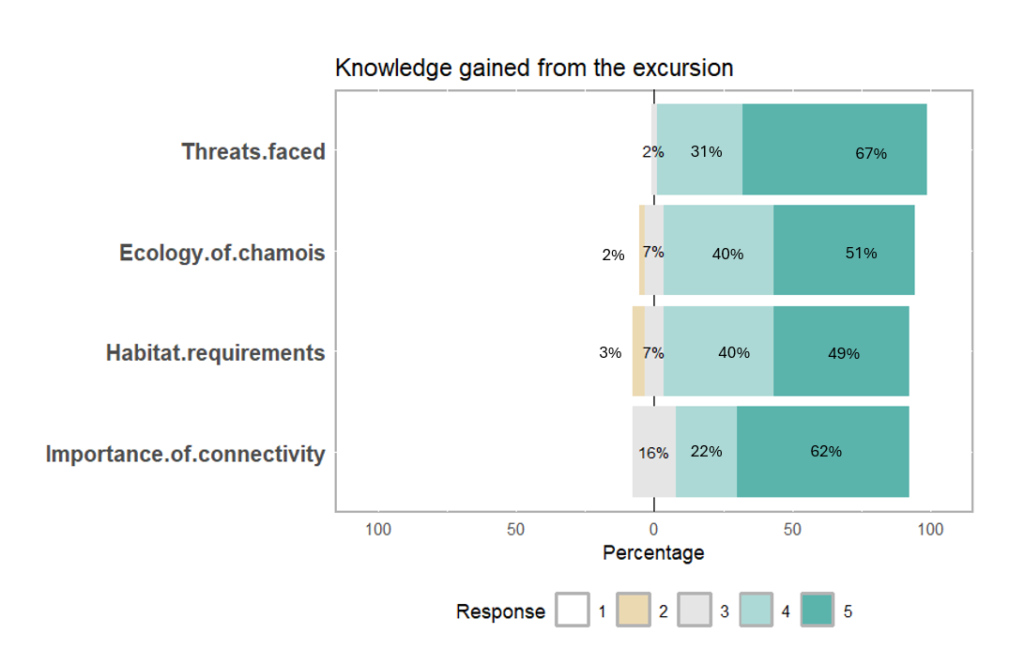
Figure 2. Knowledge gained by participants from the excursion, assessed on a Likert scale (1–5), where 1 = not at all, 2 = a little, 3 = medium, 4 = much, and 5 = very much.
Q3. Perceptions on the importance of habitat connectivity
Question asked: “To what extent do you agree with the following statements on habitat connectivity?”
- The ability of the chamois to move freely between areas is essential for its survival
- Habitat fragmentation can lead to isolation and genetic weakening of chamois
- It is important to maintain or restore ecological corridors for the species
Responses were given on a Likert scale from 1 = not at all, 2 = a little, 3 = medium, 4 = much, 5 = very much.
Participants expressed consistently high levels of agreement regarding the role of habitat connectivity in chamois conservation. On a 1–5 Likert scale, mean responses ranged from 4.56 to 4.73 across the three items. Across all statements, the vast majority of participants (89–94%) selected the top categories (“much” or “very much”), while only a small minority reported medium levels of agreement and none chose the lower categories (Fig. 3).
These results reflect a broad consensus among participants on the essential role of habitat connectivity in ensuring the long-term survival of the chamois.
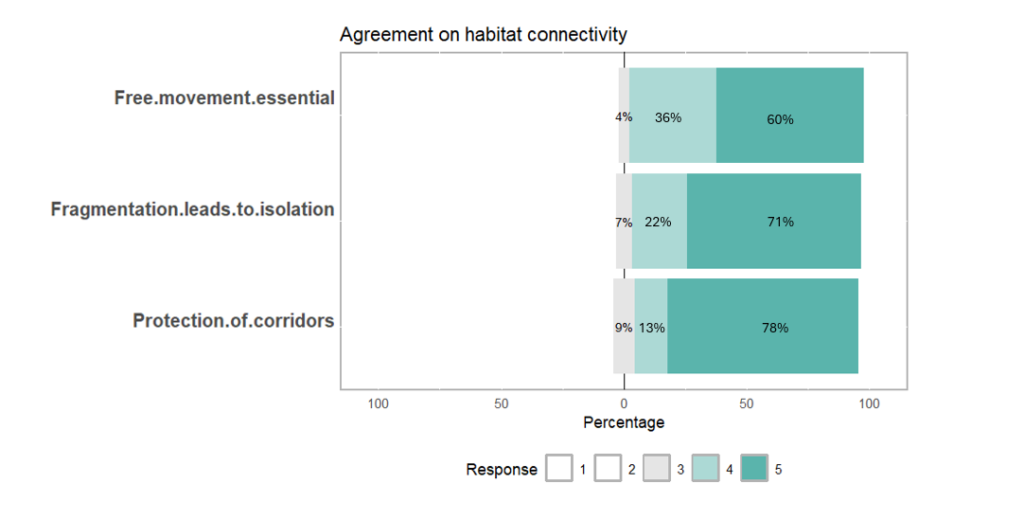
Figure 3: Agreement of participants with statements on habitat connectivity for the chamois, assessed on a Likert scale (1–5), where 1 = not at all, 2 = a little, 3 = medium, 4 = much, and 5 = very much.
Q4. Inspiration for future actions
Question asked: “How much did this excursion inspire you to…”
- Spend more time in the mountains
- Contribute to the protection of mountain ecosystems
- Support conservation actions for the chamois
- Support actions for maintaining or restoring habitat connectivity for the chamois
Responses were given on a Likert scale from 1 = not at all, 2 = a little, 3 = medium, 4 = much, 5 = very much.
Participants reported that the excursion provided a strong source of inspiration for future actions. Reported motivation was consistently high across all four items, with mean values ranging from 4.31 to 4.44. More than 90% of respondents selected “much” or “very much” for spending more time in the mountains and contributing to the protection of mountain habitats, while similarly high proportions indicated support for protecting the chamois and maintaining ecological corridors (Fig. 4). Only a small minority selected medium or lower values.
These results highlight the role of experiential activities in strengthening pro-conservation attitudes and intentions among participants.

Figure 4. Inspiration of participants for future actions following the excursion, assessed on a Likert scale (1–5), where 1 = not at all, 2 = a little, 3 = medium, 4 = much, and 5 = very much.
Q5: Experience with chamois and future engagement
Questions asked:
- 5a. Had you seen the chamois before this excursion? (Yes/No)
- 5b. Did you see the chamois during the excursion? (Yes/No)
- 5c. Do you now feel more capable of identifying the chamois? (Likert 1–5)
- 5d. Would you use the “Agriogido” app for reporting chamois? (Likert 1–5)

Figure 5. Participants’ experiences and engagement with the excursion. Top: percentage of respondents who had previously seen the chamois and those who observed it during the excursion (Yes = green, No = red). Bottom: participants’ self-reported ability to identify the chamois and their willingness to use the Agriogido app for reporting observations, assessed on a Likert scale (1–5), where 1 = not at all, 2 = a little, 3 = medium, 4 = much, and 5 = very much.
Before the excursion, 31% of participants had previously observed a chamois, while 69% had never seen the species (Fig. 5). During the excursion, however, all participants (100%) observed chamois, ensuring that every attendee had the opportunity for direct wildlife experience.
Following the excursion, 73% of participants felt much or very much more capable of identifying the species, while most of the remainder gave a medium rating. Similarly, 67% expressed strong willingness (much or very much) to use the “Agriogido” app for reporting observations, with very few selecting the lowest categories.
Taken together, these findings indicate that the excursion offered participants not only the opportunity to directly observe the chamois in its natural environment but also helped to strengthen their confidence in species identification and stimulated their interest in future engagement with citizen science. This underscores the potential of such field-based activities to foster lasting connections between people, wildlife, and conservation.
Q6. Most important experience
Question asked: “What was the most important experience you gained from this excursion?”
Participants’ open-ended responses provided rich qualitative insights into the impact of the excursion. Thematic analysis of the responses revealed these five categories, summarized in Table 1 and Figure 6 along with illustrative quotes translated into English. Nearly half of respondents (49%) emphasized the unique opportunity to directly observe the chamois in its natural habitat, often describing this as an impressive and memorable moment. A large proportion (41%) highlighted the knowledge they gained about the species’ ecology, biology, and conservation, ranging from detailed aspects of its behavior and anatomy to a broader ecological understanding. Several responses (16%) stressed that the excursion deepened their awareness of the need to protect the chamois and its habitats, underlining the importance of conservation action. Others (16%) underlined the value of spending time in nature and the mountains, which fostered a sense of connection to the landscape. Finally, more than a quarter of participants (27%) referred to the positive social dimension of the group experience, emphasizing the good atmosphere, shared learning, and enjoyment of participating together.
Together, these findings show that the excursion offered not only an educational benefit but also an emotional and social experience, strengthening participants’ connection with both the species and its environment, while reinforcing awareness of the importance of its conservation.
Table 1. Main themes emerging from participants’ open-ended responses to the question “What was the most important experience you gained from this excursion?” (N = 38). The table presents the proportion of participants who mentioned each theme, together with illustrative quotes translated from Greek.
| Theme | % of responses (N = 38) | Example quotes (translated) |
| Direct observation of the chamois | 49% (18/37) | “The observation of such a wild native animal in its habitat.” “The opportunity to see the chamois in its natural environment.” |
| Knowledge and learning | 41% (15/37) | “I gained valuable knowledge about the ecology and conservation of the chamois.” “I learned what kind of hooves the chamois has.” |
| Awareness of conservation importance | 16% (6/37) | “We understood the importance of protecting its habitats.” “The encounter with the chamois and the need for its protection.” |
| Connection with nature and mountains | 16% (6/37) | “Contact with the mountains and nature, teamwork, enjoyment.” “That it is important to maintain our connection with nature and the species that live there.” |
| Group experience and atmosphere | 27% (10/37) | “A very nice group with energy and rich interests.” “Good atmosphere and the transfer of valuable knowledge.” |
Note: Because several participants mentioned more than one theme, percentages add up to more than 100%.

Figure 6. Main themes emerging from participants’ open-ended responses to the question “What was the most important experience you gained from this excursion?” (N = 37). Bars show the percentage of participants who mentioned each theme.
Conclusions
Across all questions, participants evaluated the excursion very positively. In the overall rating (Q1), the activity received near-perfect scores, reflecting a high level of satisfaction. The excursion also substantially enhanced participants’ knowledge (Q2), particularly regarding threats to the chamois, habitat connectivity, and the species’ ecology and requirements, with almost all responses concentrated in the two highest Likert categories. Similarly, participants expressed strong agreement on the importance of habitat connectivity (Q3), recognizing the essential role of free movement, the negative effects of fragmentation, and the need to protect ecological corridors.
The activity further served as a source of inspiration for future conservation actions (Q4), with participants indicating high willingness to protect mountain habitats, support chamois conservation, and engage in actions related to habitat connectivity. The excursion also provided valuable direct experiences with the species (Q5): while only one-third had previously seen a chamois, all participants observed it during the excursion. This encounter was accompanied by improved self-reported identification skills and a willingness to engage in citizen science through the Agriogido app. Finally, the open-ended reflections (Q6) reinforced these findings, with participants most frequently highlighting the unique experience of observing the chamois in its natural habitat, alongside gains in knowledge, heightened conservation awareness, connection with nature, and appreciation of the positive group atmosphere.
Taken together, these results demonstrate that the excursion was highly effective not only in transmitting ecological knowledge and conservation values, but also in fostering emotional, experiential, and social connections with the chamois and its environment. Such activities can therefore play a crucial role in building support for biodiversity conservation and citizen engagement.
